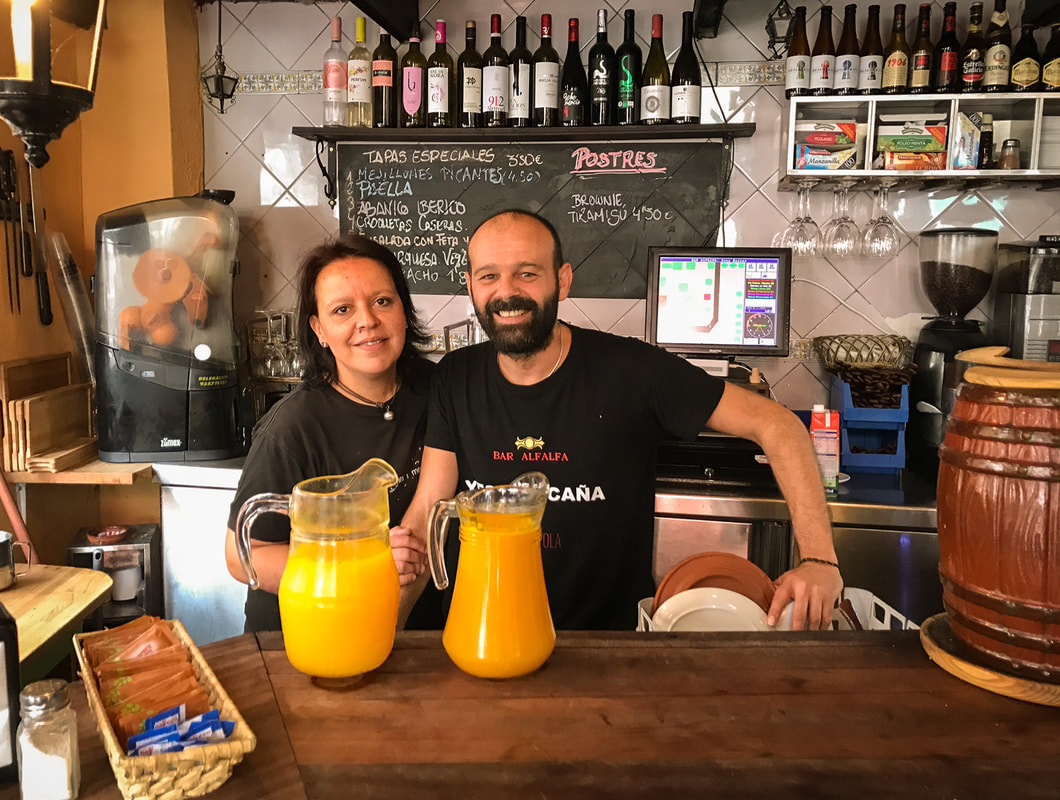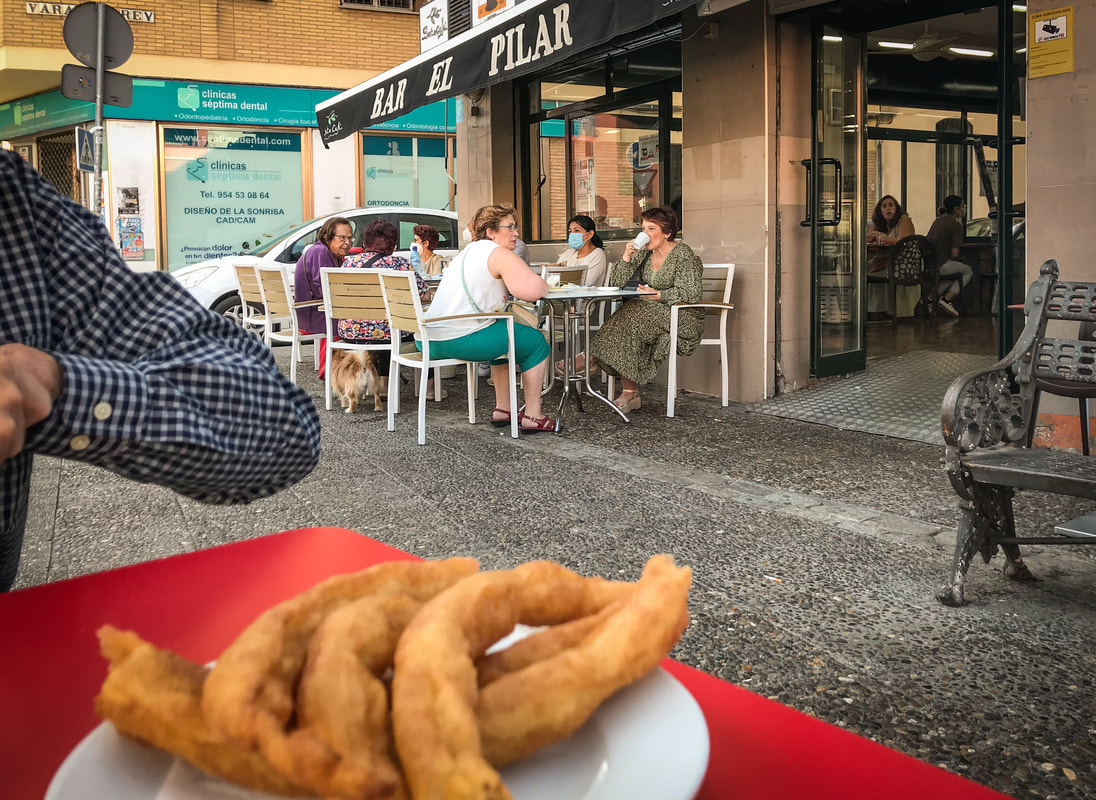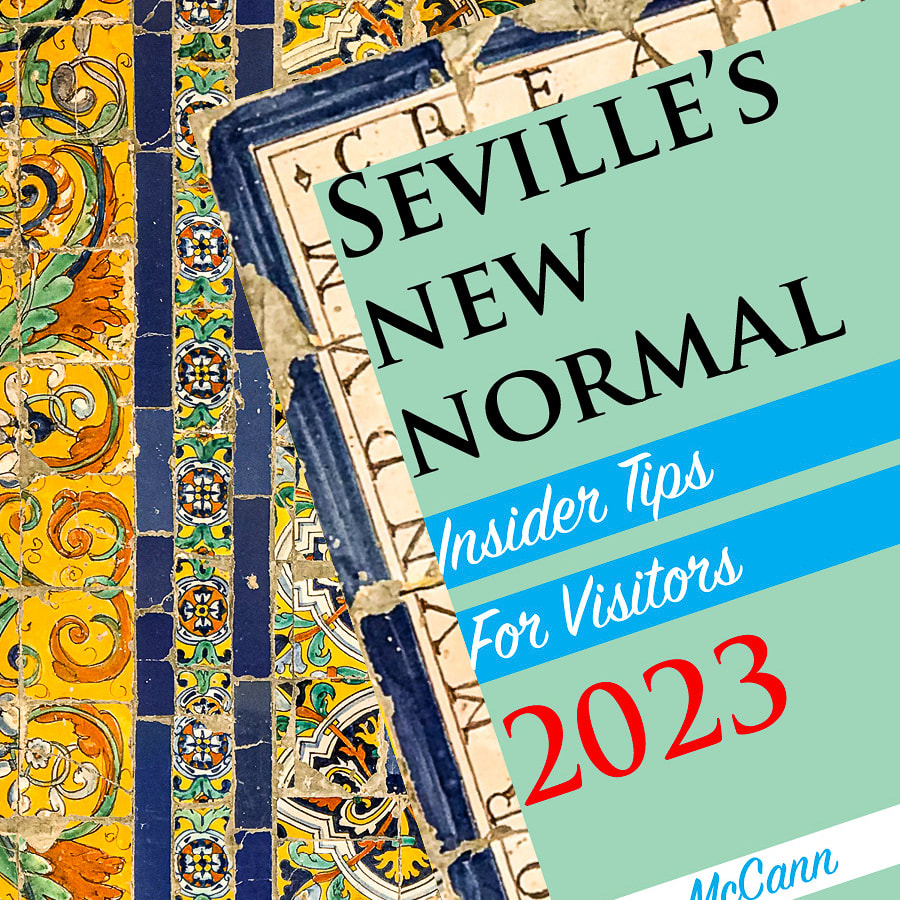|
The idea that “breakfast is the most important meal of the day” was invented by 19th century cereal manufacturers, most probably John Harvey Kellogg, a religious zealot who believed eating breakfast cereal would make Americans strong enough to stop thinking about sex. (It didn’t. Go figure.) The Spanish, who have no such Puritan goals, enjoy their version of breakfast so much they indulge in it twice every morning, with great enthusiasm. At home, Sevillanos typically start the day with a first desayuno of coffee and toast topped with olive oil and ham or butter and jam. They then head to their workplace and put in an hour or two of labor, after which they’ll refresh themselves with a midmorning break at a nearby café, enjoying another round of coffee and toast to fortify themselves until lunch. To accommodate the second-breakfast habit, the city has café-bars on practically every block. Some are grand, an increasing number are corporate efforts, and the hipsters outdo one another in providing quirky environments, flat whites, and wifi workspaces. But the mainstay continues to be modest little neighborhood places you wouldn’t look at twice in the US. To American eyes, inexpensive furnishings suggest substandard coffee and cheap food, but that’s not the case in Seville. The other morning we tried the Bar Algabeño, tucked between the Feria Market and the 15th century palace of the Guzmanes of La Algaba (now municipal offices and a museum). We found the Algabeño’s coffee and toast delicious, and the back alley location (which in the US would be another red flag) makes it a great place to watch locals going about their day. The Catunambu, on the bustling shopping street Calle Sierpes, couldn't be more visible, yet many Americans bypass it for the nearby Starbucks. So you’ll mostly find Spaniards at the Catunambu, taking a leisurely second breakfast to restore themselves after the rigors of a shopping spree. In the photo below, the individual in the big orange hat is almost certainly a foreigner, as local women never wear hats in town unless dressed to the nines for a fancy wedding, and Sevillano guys, if they wear hats at all, stick to Panamas. So what’s everybody ordering for their second breakfast? The choices may be simple, but to get it right requires a fair amount of vocabulary. In Seville, you always order your drink first. The classic is café con leche, half espresso and half steamed milk. Too much milk? Try a cortado, a shot of espresso with half as much milk. Need even more of an eye-opener? Ask for a café solo, a straight shot of espresso. Prefer something lower octane? Café Americano is plain black coffee, and leche manchada (literally “stained milk”) is half an inch of espresso and plenty of milk. I’ve never seen low-fat milk here, but hipster and tourist coffee houses may offer milk alternatives. However, no one will understand a request for “leche de soya” (soy milk), “leche de avena” (oat milk), or the like because everyone knows milk is produced by lactating mammals, not plants. The barrista will be dumfounded by your ignorance but too polite to say so. Ask for bebida de soya (soy drink) or bebida de avena (oat drink) instead. It’s even more complicated if, like me, you happen to like tea with milk, which is unheard of here. Ask for té con leche (tea with milk) and you’ll be served a glass of steamed milk with a tea bag in it. If you ask for té con leche aparte (tea with milk apart or on the side) they’ll bring you tea but not the milk, assuming you’ll drink that later in the meal or want it left in the kitchen for esoteric reasons known only to mad foreigners. Té con leche aparte para añadir (tea with milk apart to add in) should do the trick, although you may have to repeat it several times to be understood. You can see why I gave up and switched to café con leche. As for food, toast is such a given you don’t even have to say tostada; you simply order a media (half a small baguette) or entera (entire baguette) and name your toppings. The most common are jamón (thin slivers of Spanish ham), tomate (tomato) which can be ordered with or without the ham, and mantequilla y mermelada (butter and jam). If you want heartier or more familiar fare, such as eggs, avocado toast, or corn flakes, you may find them in places that cater to out-of-town visitors, but you won’t see a lot of Sevillanos eating them. I once made pancakes for a Spanish house party, and they all looked aghast, took one courtesy bite, and went back to their tostadas with sighs of relief. Some years ago, when I did a post about Spanish breakfasts, my long-time reader Vera wrote in to ask why I didn’t mention churros and chocolate, and I had to agree this was a serious oversight on my part. To my brother Mike, a devout chocaholic, this is undeniably Seville's breakfast of champions. You start with churros — sizzling fried tubes of dough — which you proceed to dunk in hot chocolate as dense as pudding. I know, right? Possibly the most decadent breakfast ever invented and naturally a huge favorite with the Sevillanos. It’s mostly a Sunday indulgence but is occasional used to reanimarse (reanimate yourself) en route home from a party at six in the morning or eaten as your marienda, the post-siesta snack that’s essentially a third breakfast. “Rich,” I said, “we have to go out for churros and chocolate. It’s research.” “I am willing to make the sacrifice,” he said. “For your readers.” The article 5 Places for the Best Churros in Seville named El Pilar numero uno, and as this is a favorite of ours, Rich and I headed there directly. Unfortunately we arrived during the second breakfast rush, and every outdoor seat was taken. As we hovered uncertainly on the outer edges of the small crowd, an older gentleman rose slowly to his feet and said, “Please, take my table. I insist.” He picked up his half-finished coffee and headed indoors, our fulsome thanks ringing in his ears. The churros and chocolate were first rate: hot, dense, and fortifying to the physique. The bill came to 5.60€ ($6.47), and when Rich handed the waitress a 5 euro bill and a euro’s worth of change, she counted the money and exclaimed, “Sir, you have overpaid me!” And tried to give back the 40 centimos. You have to love a place with that kind of attitude. For Sevillanos and others who love the city, desayuno is one of life’s great treats and once a day simply isn't enough. Most of us have a regular café where we no longer have to order our second breakfast; the camarero automatically places our favorite configuration of coffee and toast on the bar, perhaps nudging a bottle of olive oil in our direction so we can drench our toast even further. I can only imagine how John Harvey Kellogg is turning in his grave at the very idea of all that pleasure packed into a morning meal. But hey, it works for me. YOU MIGHT ALSO ENJOY
As I resettle in Seville, my favorite city on the planet, I'll keep you posted on how the pandemic has reshaped the landscape. But don't worry: not even Covid could dampen the city's appetite for good food. CLICK HERE TO RECEIVE FREE UPDATES on Seville, travel to Europe, and where to find good eats and survival comforts.
16 Comments
Denise San Antonio Zeman
10/12/2021 06:23:50 pm
Delightful post... especially as I now have a great rationale for my second breakfast! I'm a very early riser, so waiting almost 6 hours for lunch just doesn't cut it for me.
Reply
Karen McCann
10/13/2021 07:22:10 am
It's just common sense, Denise. We early risers need our second breakfasts to survive until lunch. I have several friends who are on fasting diets these days, eating only after sundown. I so admire their stamina but am very glad not to be going that route. My blood sugar is happiest when topped up at regular intervals!
Reply
10/12/2021 07:55:25 pm
Two, possibly THREE, breakfasts? I was clearly born in the wrong country!
Reply
Karen McCann
10/13/2021 07:24:00 am
I know, right? How did any of us make it this far in life without two to three breakfasts a day? Why has this sensible approach not spread around the world? I guess those are questions for future historians to decide. I'm just glad we stumbled on this wisdom and can make our own rules about breakfast from now on.
Reply
10/12/2021 08:51:45 pm
We love second breakfast! And, it is so good to hear that El Pilar made it through covid. Robert thought they had the best churros in Seville. I prefer the ones at Churreria La Esperanza, but that might have been more about the experience (all locals, small little tables to stand around). We are eating vicariously through you! But we hope to be back soon to check out all our old favorites.
Reply
Karen McCann
10/13/2021 07:32:51 am
I hope you two do get back here soon, Lisa. I'd love to compare notes. I haven't had the churros at La Esperanza, so obviously Rich and I have to do some more research. Meanwhile friends keep saying, "What, you haven't been to Maya Brunch for the avocado toast yet? What about Otto? Mimo?" I'm beginning to think two breakfasts a day may not be enough.
Reply
Faye
10/13/2021 02:40:21 am
Love this post! Morning food is always the best and to have it two or three times a day is wonderful. I will make a copy of all these coffee drinks just in,case I go back to Spain. I was in Barcelona three years ago and it took me forever to order a coffee as the waitress did not understand anything I said. Nevertheless, I got a delicious coffee with cream/milk and ordered it 3 times before leaving as it was so good. Possibly I was still exhausted from all the touring but it was the best coffee ever!
Reply
Karen McCann
10/13/2021 07:37:44 am
Spanish coffee is terrific, Faye, and I'm so glad you found one you liked. A lot of Americans visitors make a beeline to Starbucks so they can order something familiar, but they are missing out on some great stuff! I always try to persuade them to give local coffee a try. Delicious and a third the price!
Reply
10/13/2021 05:15:14 am
Thanks for making the great sacrifice of going out for churros and chocolate! One of the mysteries of the universe is why some American hasn’t started a Churros and
Reply
Karen McCann
10/13/2021 07:40:23 am
Thanks for giving me the nudge, Vera. We thoroughly enjoyed our run to Pilar for churros and chocolate. And you're right, it is a wonder no one has launched a chain to bring them to the US. Although perhaps it's just as well; they'd never leave it alone and would keep tinkering with the recipes. Can you imagine low-fat, lactose-free chocolate with gluten-free churros? It just wouldn't be the same.
Reply
Lucinda Herrick
10/13/2021 06:19:59 pm
Oh my gosh! You made me long for Spain. Blessed to have been there twice (daughter married in village south of Granada) and we loved churros, olives, jamon, the wines...and so much more. Since my MA is in Spanish Colonial art I was on cloud nine in Seville.
Reply
Karen McCann
10/16/2021 04:33:15 pm
You were indeed blessed to visit this wonderful country, Lucinda, and I can only imagine how having an MA in Spanish colonial art would enrich your pleasure at seeing the grand architecture of Seville. No matter how long I live here I'm always gobsmacked by the exuberance of the style. Hope you get to come again one of these days.
Reply
Angela Highstead
10/14/2021 02:16:54 am
Well, fancy that! We have churros and chocolate stores here in ‘Oz’ sometimes almost next door to ‘Macca’s’ - Australian slang for MacDonalds.
Reply
Karen McCann
10/16/2021 04:38:12 pm
Glad you enjoy the column, Angela. As you can imagine, it's good fun to research, write, and discuss with readers. And if people in Oz are eating lunch at Macca's and following that with churros and chocolate for dessert, please don't tell me; around here that would be a heresy equal to the no-cappuccinos-after-breakfast rule. I don't want to have to share news of such shocking rule-breaking with my Spanish friends!
Reply
Teresa Flagg
10/19/2021 02:28:44 am
Karen, your posts always make me miss Sevilla (in a good way :) ), but this one especially. I used to love the Sevillano second breakfast and was fascinated by the idea of olive oil on toast. This reminds me how much I used to love Spanish bars for their versatility - from breakfast in the morning until drinks late at night. So glad you two are finding this still a wonderful thing in post-covid (well, almost?) Sevilla.
Reply
Tia Welch Maerz
10/21/2021 05:43:35 pm
The bit about ordering your drink in a cafe reminded me of my first trip to the Mas y Mas grocery store in 2005. I was searching for milk in the refrigerated section, not knowing that Spaniards store it in boxes, and not refrigerated. I asked the cashier, in Spanish, where the milk was. So nervous! He replied “Que tipo?”. Me, deer caught in the headlights, immediately scrolled through goat milk, sheep milk, yak milk, and answered “De Vaca”. Puzzled, he led me to the wall where I could select whole milk, 2%, non-fat, etc. My ignorance exposed, I quickly paid and left. I always enjoy your posts, Karen. You have a real flair!
Reply
Leave a Reply. |
This blog is a promotion-free zone.
As my regular readers know, I never get free or discounted goods or services for mentioning anything on this blog (or anywhere else). I only write about things I find interesting and/or useful. I'm an American travel writer living in California and Seville, Spain. I travel the world seeking eccentric people, quirky places, and outrageously delicious food so I can have the fun of writing about them here.
My current project is OUT TO LUNCH IN SAN FRANCISCO. Don't miss out! SIGN UP HERE to be notified when I publish new posts. Planning a trip?
Use the search box below to find out about other places I've written about. Winner of the 2023 Firebird Book Award for Travel
#1 Amazon Bestseller in Tourist Destinations, Travel Tips, Gastronomy Essays, and Senior Travel
BLOG ARCHIVES
July 2024
CATEGORIES
All
|




















